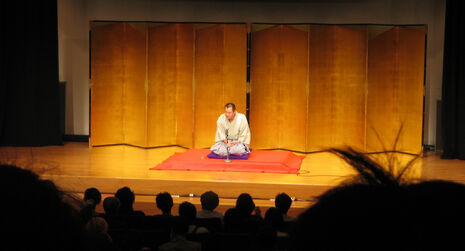Different Subjects: AMES and Art
In the second part of a series on how our academic studies inform a love of art, Stella Dixon explains how Japanese art has shown her the beauty of things we often overlook.

Like most people, I am guilty of taking art for granted. When I was younger, art meant being dragged around a gallery with my parents, or miserable attempts in the classroom to make my utter lack of painting ability into something worthwhile. Art seemed out of reach, the pastime of people with what seemed like magical talents and, more importantly, the time to focus on them.
But since I started studying Japanese culture, I have found that art is far more universal than I thought, and this realisation has helped me introduce more art into my life.
A good starting point is the recent BBC Four documentary The Art of Japanese Life. In some ways, it reinforces the idea that art is out of touch – the focus is often on somewhat stereotypical remnants of elite Japanese culture like flower arranging, calligraphy and woodblock prints. But in focusing on the art of the everyday, it uncovered a spirit of aesthetics that certainly isn’t exclusive to the few.
Take rakugo theatre as an example, a genre involving humorous stories of everyday life told by just one person and two props: a paper fan and a towel. While applying to my course I had the good fortune to be able to witness a rakugo performance by one of the teaching staff, Dr Shores, as part of the faculty open day. He told his own story too, and it turned out he had spent years as an informal apprentice to a rakugo master in Japan, carrying out hours and hours of chores, just to learn to imitate everyday actions like slurping noodles out of a bowl.
Needless to say his performance was enchanting, and very, very funny. What really amazed me, though, was the elevation of things like messily eaten noodles or a walk down the street to the status of art. I had never considered that such mundane things might be the subject of all that effort. And once rakugo alerted me to it, I couldn’t stop noticing examples of the mundane being projected to stardom within Japanese culture, especially literature.
I Am A Cat was written around 1905-06 by Natsume Soseki. The entire narrative is from the perspective of a nameless cat; through its eyes, Soseki presents a sophisticated analysis of the role of foreign influences in Japan.
This sounds serious, but most of the focus is on the (decidedly average) owner of the cat and his everyday predicaments – trips to the local bath-house, failed attempts at poetry and watercolour painting, and gossiping with his equally bumbling friends. The book’s focus on an imperfect protagonist despite its important message helps to involve normal people in the story, while its origins in a magazine as a collection of weekly short stories show its grassroots appeal.
Enjoyment of the everyday extends far beyond the traditional arts of literature and theatre. Japanese culture is often said to promote an appreciation of the environment, both in the natural and man-made worlds. Tokyo is one of the busiest cities on the planet, yet thousands of people gather every year to observe the cherry blossom season at its height and appreciate the beauty in their daily surroundings.
“Once we appreciate the work that goes into creating the world around us – both the work of nature and the work of humanity – it makes it easy to see the art that surrounds us every day.”
This appreciation also follows people through the door and inside their homes – minimalism has its roots in modern Japan, and endless books abound preaching the benefits of maintaining both a physically and spiritually uncluttered existence. The idea that everyday life can be cultivated and tamed is arguably a way of turning the lives of city dwellers into something richly creative.
Of course, I’m not saying that all Japanese people are connoisseurs of art – sweeping generalisations do nobody any good. But much of the art in Japanese society is intended to blend into the everyday and be accessible, from the production of beautifully detailed drawings for the latest slice-of-life anime series to the careful design and construction of vehicles. Endless work and training goes into producing these things, yet they appear completely effortless.
This attitude to art is certainly not exclusive to Japan. In British culture and beyond we also find hundreds of examples of everyday art, often in the most unexpected places. Gardeners, athletes, engineers, foot-traffic analysts, all manipulating the boundaries of knowledge and ability to create something that works and flows with the illusion of it being an act of nature. Once we appreciate the work that goes into creating the world around us – both the work of nature and the work of humanity – it makes it easy to see the art that surrounds us every day.
But without first examining another culture and its attitude to art, I doubt I would have been able to see this same spirit right at home. A lot of the time, it takes an outside perspective to notice these things. In the end, it seems that art truly is everywhere - and I have my subject to thank for teaching me where to look
 News / Downing investigates ‘mysterious’ underground burial vault 29 December 2025
News / Downing investigates ‘mysterious’ underground burial vault 29 December 2025 News / Unions protest handling of redundancies at Epidemiology Unit30 December 2025
News / Unions protest handling of redundancies at Epidemiology Unit30 December 2025 Lifestyle / Ask Auntie Alice29 December 2025
Lifestyle / Ask Auntie Alice29 December 2025 Features / ‘Treated like we’re incompetent’: ents officers on college micromanagement30 December 2025
Features / ‘Treated like we’re incompetent’: ents officers on college micromanagement30 December 2025 Science / Astronomical events to look out for over the break29 December 2025
Science / Astronomical events to look out for over the break29 December 2025










